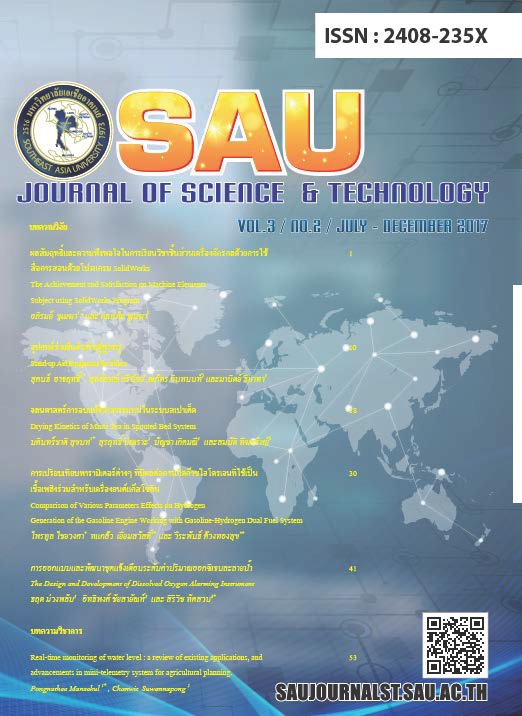Comparison of Various Parameters Effects on Hydrogen Generation of the Gasoline Engine Working with Gasoline-Hydrogen Dual Fuel System
Main Article Content
Abstract
This project is an experimental research that related to parameters which affected to Oxygen forming to be used as co-fuel for Gasoline engine. The reactor is designed by using water 1000 cc to be used as electrolyte, using 304-stainless plate with the size of 4x8mm and 2mm thickness as electrode and using 12V, 65 Ah as power supply. Procedure is consisted of adjusting parameters that consists of plate cell, gap among plate cell and concentration of solutions. The experimental result is then compared that is consisted of gas flowing ratio, current that flows through plate cell, temperature of reactor and voltage of battery and also the result of using hydrogen to be used as co-fuel for gasoline engine. The experiment found that reactor that is filled solution into 11-cell electrolyte and distance among cell is 2 mm. can provide the maximum flow of oxygen. Oxygen is then used as co-fuel for gasoline engine indicated that 1600 cc cylinder gasoline engine using gasoline with hydrogen is able to save the maximum fuel of 25%, at speed of 1500 rpm when it is compared with the normal fuel system of gasoline engine.
Article Details
References
[2] W. McDonall, M. Eames, Forecast, scenarios, visions, backcasts and roadmaps to the hydrogen economy: a review of the hydrogen futures literature., Energy Policy, 34 (2006)1236 – 1250.
[3] K. Zhou, J. Ferreira, S.D. Haan, Optimal energy management strategy and system sizing method for standalone photovoltaic-hydrogen systems., Inter. J. Hydrogen Energy, 33 (2008) 477 – 489.
[4] S. SA, B. F, V. TN, Wind energy and the hydrogen economy-review of the technology., Solar Energy, 78 (2005)647 – 660.
[5] V. Pérez-Herranz, M. Pérez-Page, R. Beneito, Monitoring and control of a hydrogen production and storage system consisting of water electrolysis and metal hydrides, Inter. J. Hydrogen Energy, 35 (2010) 912–919.
[6] J.C. Ganley, High temperature and pressure alkaline electrolysis, Inter. J. Hydrogen Energy, 34 (2009) 3604–3611.
[7] K. Schoots, F. Ferioli, G.J. Kramer, B.C.C.v.d. Zwaan, Learning curves for hydrogen production technology: An assessment of observed cost reductions, Inter. J. Hydrogen Energy, 33 (2008) 2630–2645.
[8] G.E. Ahmad, E.T.E. Shenawy, Optimized photovoltaic system for hydrogenproduction, Renewable Energy, 31 (2006) 1043–1054.
[9] E.T.E. Shenawy, H. H., Annual Performance of a Photovoltaic Hydrogen Electrolyzer System in Egypt, in: The Pacific Rim Energy and Sustainability Congress, The Hiroshima Crowne Plaza, Japan, 2012.
[10]Z. Wang, R.R. Roberts, G.F. Naterer, K.S. Gabriel, Comparison of thermochemical, electrolytic,
photoelectrolytic and photochemical solar-to-hydrogen production technologies., Inter. J. Hydrogen Energy, 37(21)(2012)16287–16301.
[11] A. Ramadan, E. El-Shenawy, A.A. Dayem, S. Eid, A. Optimization of PV-Hydrogen Electrolyzes System, in: Third International Conference on Engineering Science & Technology, Cairo, Egypt, 2008.
[12] N. Chennouf, N. Settou, B. Negrou, K. Bouziane, B.Dokkar, Experimental Study of Solar Hydrogen Production Performance by Water Electrolysis in the South of Algeria, Energy Procedia, 18 (2012) 1280 – 1288.
13] D.M. See, R.E. White, Temperature and concentration dependence of the specific conductivity of concentrated solutions of potassium hydroxide, J. Chem. Eng. Data, 42 (1997) 1266-1268.
[14] H. Wendt, H. Plzak, Hydrogen production by water electrolysis, Kerntechnik, 56 (1991) 22–28.
[15] Æ. Ulleberg, Modeling of advanced alkaline electrolyzers: a system simulation approach, Inter. J. of Hydrogen Energy, 28 (2003) 21-33.
[16] X. Qin, F. Gao, G. Chen, Effects of the geometry and operating temperature on the stability of Ti/IrO2–SnO2-Sb2O5 electrodes for O2 evolution., J Appl Electrochem, (2010)1797–1805.
[17] Allenby, S., Chang, W.C., Megaritis, A. and Wyszynski, M.L., 2001, "A Way to maintain Combustion Stability in Natural Gas Fuelled Engine with EGR, the Potential of Fuel Reforming", Journal of Automobile Engineering, Vol, 215, Part D., pp.405-418
[18] Sierens,R. and Rosseel, E., 2000, "Variable Composition Hydrogen/Natrual Gas Mixtures for Incerased Engine Efficiency and Decreased Emissions", ASME Journal of Engineering for Gas Turbines and Power, Vol. 122, pp. 135-140
[19] Larsen,J.F. and Wallace, J.S., 1997,"Comparison of Emissions and Efficiency of a Turbocharged Lean-Burn Natrual Gas and Hythane-Fuelled Engine", ASME Journal of Engineering for Gas Turbines and Power, Vol. 119, pp. 218-226
[20] Raman, V., Hansel, J., Fulton, J., Lynch, F. and Bruderly, D., 1994, "Hythane-An Ultra Clean Transportation Fuel", Proceeding 10th World Hydrogen Energy Conference, Cocoa Beach, Vol. 3, pp. 1797-1806
[21] P. Chaiwongsa, N. Pornsuwancharoen, P.P. Yupapin, Effective hydrogen generator testing for on-site small engine, Frontier Research in Nanoscale Science and Technology, Physics Procedia 2 (2009) 93–100


